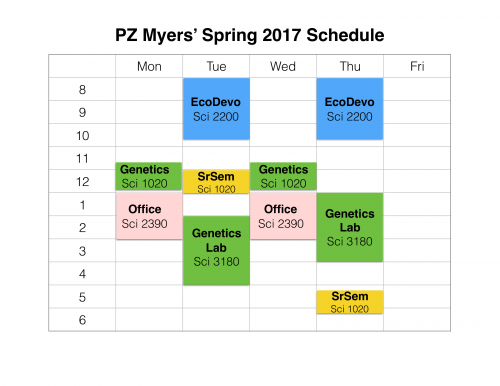Hola, amigos, it’s been a long time since I rapped at you, but I’ve been busy. I’ve been staring at calendars and juggling time in my head. I sort of had to gaze in horror at my spring semester schedule, and had to spend some time working on my other classes. Here’s what my weekly calendar looks like:
One thing is very nice: I’ve arranged to have Fridays wide open. That does not imply that I’ll spend every Friday in my PJs sipping Scotch — that’s when I’ll be catching up on grading and composing lectures for the coming week. But hey, it also means if anyone wants to invite me out to speak somewhere, I’ve got a 3-day weekend every week.
Other days are mostly gutted by my genetics and genetics lab courses, which will take up the bulk of my time. Those lectures are mostly already planned out and done, as I’ve taught this course every year for almost two decades now. There’s still a lot of work required there, and I have to keep that in mind when budgeting time for this course, Ecological Developmental Biology. Right away, you might spot the fresh horror involved in that class: it’s a 100 minute lecture course, twice a week, at 8am. Ack. I’ve got to be ready to go first thing those mornings, and I have to have a larger than normal block of material. Double ack: students have to be awake and alert.
So right away, I’ve decided that that’s too much for early morning attention spans. Each class is going to be broken in two, with a break in between. I’m going to bring in my tea kettle to class, and it’ll be enough time that if they want to run over to the next building and grab coffee, that’s going to be fine. Let’s be civilized about all this.
I’m also going to mix up my teaching style. I plan to give a lecture-style general overview of a topic from the textbook in the first half, recess briefly for coffee and tea, and then meet again for a more detailed, interactive discussion, using a paper from the primary literature as a nucleus for the conversation. That also sounds pleasant and civilized. There will be some exceptions to that, though.
This is the only course in developmental biology these students will have taken, so I feel some obligation to bring them up with the basics of the field. The first two weeks will be a crash course in development, hitting some key processes that they ought to understand before we dive deeper. So on my calendar I’ve blocked out the first two weeks to include short lectures in the history and philosophy of development, polarity, gastrulation, limb development, and craniofacial development. Again, brief overviews of those topics suited to early morning undergraduates, with time for discussion and interaction. Fortunately, Scott Gilbert’s Developmental Biology text is available for free on NCBI, so I can assign supplemental readings from that.
What about assessment? First day I’m going to give them 3 assignments.
-
Read Lewontin’s The Triple Helix. This is the philosophical backbone of the course, and we’ll be discussing it in class in the third week. This discussion will be driven by questions I will ask (I’m not giving answers), and I will put individuals on the spot to answer them. This will be a preview of the oral exam they’ll be taking at the midterm.
-
Each student will be assigned a week in human development, or a key organ system, and will give a 5 minute summary presentation in the third week. I’ll make available Langman’s Medical Embryology, which is the only source they’ll use. Again, this will be a warm up to a longer presentation they’ll give at the end of the term.
-
They’re going to be warned that they’ll be given half the class period in the last weeks of the semester to individually present and discuss a topic and at least one primary research paper. Start thinking and planning!
There, I’ve already wiped out a big chunk of the semester. First two weeks, a crash course in developmental biology. Third week, a group in-class oral exam on the topic of The Triple Helix, and a series of very short presentations by the students to summarize human embryology. And then I’ve blocked off the last month of the course for in-depth student presentations.
Other assessment-related assignments: in the 6th week, they’re to give me a proposal for their presentation, with a short annotated bibliography. In the 8th week, I’ll expect an outline of their presentation. There’s no time to waste, so it all starts early, and I’m going to be mean about deadlines. I know how students can procrastinate over semester long projects.
The 8th week is also set aside for one-on-one oral exams, a half-hour per student. There will be some general questions, and I’ll also give each student some customized questions, based on their project proposal. There will also be a few pointed nudges about their progress on their presentation research.
The preliminaries and assessment are covered. What about the meat of the course, structured around Gilbert’s Ecological Developmental Biology? I’ve had to make some hard choices here. I can’t teach the whole text — as it is, I’m hitting the students with a lot of reading, and I’m already expecting that I might have to cut back on a few of my plans. I also don’t want to just teach what’s in the textbook, but will be providing papers that they’ll have to read and understand and discuss in class. What that means is that I’m doing something heretical: I’m not using the lovely material on evolution and development at the end of the book, chapters 9-11. I had to cut somewhere, and I figure enough of that will seep through in my general attitude in the course. I’m also holding it in reserve: it always happens that a student or two drops the course, especially since they’ll get early feedback on their grades, and I might just be able to fit in a little at the end, if student presentations don’t eat up the whole month. I may also steer a few of those students towards the evolution material.
I can tell them in the syllabus that the assigned readings and topics will be:
Week 1: The Triple Helix
Week 4: Chapter 1, Plasticity.
Week 5: Chapter 2, Environmental Epigenetics.
Week 6: Chapter 3, Developmental Symbiosis.
Week 7: Chapter 4, Developmental Physiology.
Week 8 will be the oral exam week.
Week 9: Chapters 5 and 6, Teratogenesis and Endocrine Disruptors.
Week 10: Chapters 7 and 8, Aging and Adult diseases, and Cancer.
Then a long block of student presentations on topics that interest them.
Week 15: if students haven’t eaten up all the time in the course, Chapter 10, Developmental Regulatory Genes.
Doesn’t that sound like fun? Intense, maybe, but you can’t learn without a little pain and effort.




For us non-biologist, popular science readers, how does Lewontin compare to Neil Shubin (Your Inner Fish) and (if one is still allowed to mention his name) Richard Dawkins?
Lewontin is a flaming radical.
Neil Shubin is progressive.
Dawkins is conservative.
Hundred minute classes twice a week at 8AM – that is brutal!
8 AM?!? Even in my twenties, I hardly ever stayed up that late!
Jim Anchower has a new career?
Jim! Jim Anchower? Wow, man, you were under some deep cover, dude. Did you ever get the Chower Mobile rolling again, dude? And it’s amazing that you parlayed that furniture warehouse job into a full-time tenure position. Must’ve been all that weed made you hella smart! Rock on!
Didn’t Peter Dervan (of CalTech) author a bunch of papers about transient triple-helix structures in DNA? I seem to remember……
Do the students run their presentation ideas through you before proceeding? In which case that’s extra work load to consider.
PZ:
Get a coffee machine installed in or near the lecture room, and have big bags of cookies ready for every break. You will be forever popular with the students. Hopefully you can put it on your expenses. It’s the cost of teaching at 8 in the morning.
I love biology and I’m old so was saving up to take your courses for my own pleasure. All those presentations though, count me out.
How many students in that 2x week EcoDevo marathon?
So… the day to “Sacrifice Virgins to the Great Old Ones” would be Friday?
My day to do that is Tuesday.
Yeah, that’s the thing many people don’t get about teaching. It’s not just the time you spend in the classroom. At least not when you care at least a little bit. All people ever see is that you get a lot of days off and that you’re often home by 2 pm (at least as a school teacher here) but then they look at you like you fell from the stars when you sit at home working from 9 to 19 on a Sunday because it’s exams time….
16 contact hours + 2hrs prep time for every contact hour and you have a 48 hour work week. Oops, I forgot the 4 hours office time that will mostly be spend advising students, now we are at 52, plus the weekend time grading tests., say about 4 hours per week. A good solid 56 hr week (on average)- and they turned down your sabbatical request. Teachers are always in the trenches, some are superhumanly dedicated.